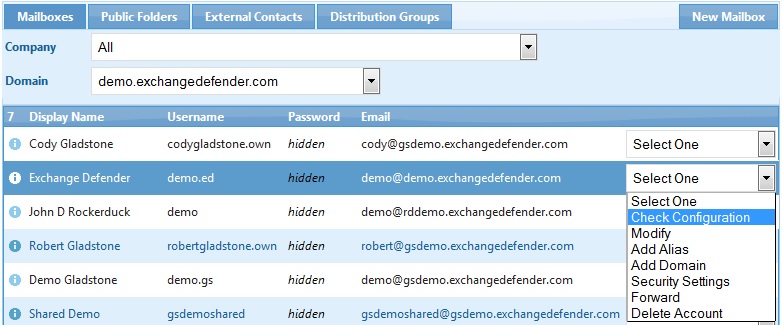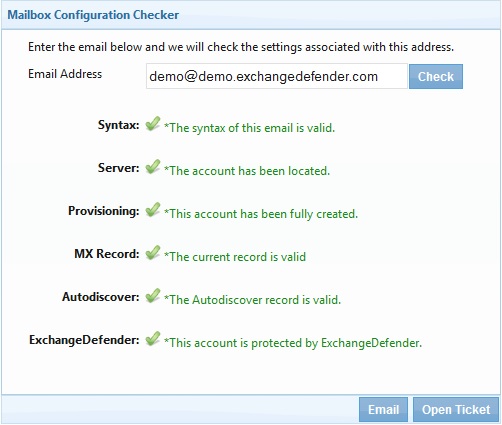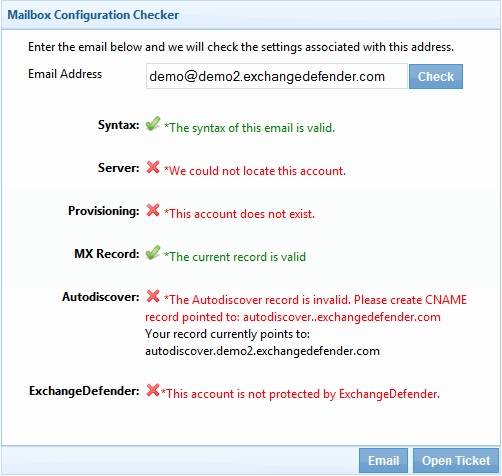Valentine’s Day Promotion

This year we’ll be focusing on our existing partner base even more. We’ll be cutting back on some of the road shows a bit and refocusing those resources to more efforts to reach out and help our current partners. We’re still offering migrations to our platform free of charge, if you aren’t aware of what we’re able to do, please give us a call at (877)546-0316.
Another step we will be taking is adding more promotions to help your growth. This month we’ll be showing you some “Love” for Valentine’s Day. Please be sure to keep an eye out in your physical mailbox. We sent out a “little something” for you guys to help you save some cash.
If you haven’t received a postcard from us by the end of next week reach out to to us we can get it to you electronically. If you need help with anything or have any questions about our free migration service please give us a call or email me and we can get the ball rolling.
Hosted Exchange – Configuration Checker
Throughout the day we receive hundreds of requests for new services and existing account modifications. Luckily we automated this process from a very early stage and this helped to prevent 99% of account provisioning errors. Believe it or not, there was once a time where everything was processed manually!
However on occasion when there is a hiccup, then it’s simple a matter of locating the source of the issue. While issues on our end are rather easy to diagnose and fix, it’s not always as simple on the partner’s side. There can be a handful of issues that can arise if the account is not properly configured or contains an invalid parameter.
This is why we’ve implemented a well overdue feature integrated directly inside the service manager. If you select the drop down box next to any Hosted Exchange account, you will see a new option called “Check Configuration”.

After selecting this option you will be brought directly to the “Check Configuration” page. It will automatically populate the email address from the previous screen and run the initial check. Also keep in mind that you are able to test other accounts without leaving this page.
It will perform several checks including: Syntax, Server Location, Provisioning, MX Record, Autodiscover and validates that the account is protected by ExchangeDefender. In the event an issue arises you have the option to either “Email” or “Open Ticket” which will automatically include the onscreen results.


We believe that solving the issue promptly makes for a better long term relationship. So if there are any features or adjustments we can make to help smooth the transaction between you and your clients, don’t hesitate to let us know! Our support staff eagerly awaits the opportunity to speak with you about how we can continue to improve our process!
Windows Web Hosting Hardware Upgrade
Platform Upgrade
If you follow our NOC you’ll notice that earlier this week we had a hardware upgrade to our Windows Web Hosting platform. Our team put in extra hours to minimize the amount of down time you and your clients would experience. The key components of the upgrade were RAM and CPU. This resulted in better performance for you and your clients.
Do I as the partner need to do anything?
There is absolutely nothing that you need to do on your end. The upgrade took place on the server side and no changes need to be made on your end. It was a seamless transition and everything from data to host IP addresses remain the same. You and your clients can use the same great product as you always have.
Additional Perks
An additional perk is on the backend of things. The new hardware allows us to perform backups and recoveries more efficiently than what was previously available. This means less down time for you and your clients in the event of a disaster.
Moving Forward
The hardware upgrade was smooth transition. Over the past few days we have seen increased performance. In addition to performance enhancements we now have a more efficient way of backing up your data. As technology is always changing we look forward to making more improvements for you across all of our platforms!
ExchangeDefender – Licensing (Enhanced)
Over the years we’ve always had a desire to increase the aspects of reporting in several areas. However due to time restraints and prioritizing our efforts towards ensuring we made our platform completely stable and continuing to provide a rock solid solution, we had to defer until later.
This has been the case for the last few years. We all worked insane hours to ensure that everyone had an awesome product, that they would be proud to call their own! Now we are enjoying the fruits of our labor and focusing on creating more of the eye popping visual features that will really help showcase our product!
As a result, I’m proud to showcase one of our latest ExchangeDefender features.
While signed in as a (Service Provider) account, you can view the licensing page located under: Licensing->Management. Here you could see the total seat count for the desired domain at a glance. We’ve expanded this to also include the ability to list each individual account under the domains. This is a toggle-able option that is off by default to help limit the initial page load for those who don’t want the extra information.

Not only that, you also have the ability to save and download a PDF of the current view. This has been highly requested by several users as to provide them the ability to keep archived copies of their seat counts each month for financial records. Other users have simply expressed the need to print these reports, which we have also implemented with one click access.

Lastly we understand that our partner’s clients also like to be kept in the loop about their spam information from time to time. Listed next to every domain is the ability to view and print the current SPAM statistics for that account. All of this information is simply one click away, quick and easy access to the information your clients want to see!
Stay tuned we’re working on even more exciting features to help ease the load of bringing a new client on-board and continuing to manage that account!
File Extension Customizations
Much like my last blog, I’ll be focusing on items I’m seeing low utilization on. This week I’ll cover file extension blocking. We’ve given you control over the file attachments that get are allowed to pass through the filter.
Some of you were part of our testing of the software and may have forgotten you set these settings. They’ll be going live, please remember that if you decide you want to now allow these items there is an update cycle that needs to happen and due to the nature of change it takes longer than our usual alias updates and such. So please login to admin.exchangedefender.com and make the changes you wish to make, there is no need to open a support request for this, this hopefully jars your memory.
There is an “exception list” these extensions we will not allow for deviation from our standards of scanning:
.ade, .adp, .bat, .chm, .cmd, .com, .cpl, .exe, .hta, .ins, .isp, .jse, .lib, .lnk, .mde, .msc, .msp, .mst, .pif, .scr, .sct, .shb, .sys, .vb, .vbe, .vbs, .vxd, .wsc, .wsf, .wsh
This is obviously for the security of your clients.
Profit opportunities you may be overlooking
Since coming back from our last trade show, I’ve been going over my notes. I focused on items that partners were unaware we offered. And the two products that keep popping up in my notes are Business Encryption and Compliance Archiving.
We offer business grade lexicon based and policy based (already included in ExchangeDefender pricing) encryption services. The lexicon based encryption adds a flexible layer to your data leak protection. You can configure keyword matches as well as dynamic regexp patterns. The regexp patterns are used to catch specific content and encrypt it or re-route it to a manager for review. As part of the service, we’re able to help you set up dynamic rules built around your client’s requirements to ensure we’re meeting their desired results.
On top of that we also offer Compliance Archiving. This product meets eDiscovery request requirements that require the ability to search for communications in an environment that cannot be edited. Also, you can increase productivity and limit support exposure with your clients. I’m sure you’ve seen plenty of enormous corrupted mailboxes, because people don’t want to delete items and mailboxes getting locked out due to quotas.
As we see the market for just email shrink in pricing (due to non business products being purchased by businesses), we have to ensure that we offer specialized value add items. These are becoming increasingly important by the day.
If you have any questions ability the capabilities or pricing of these products please give us a ring and speak to anybody here and we’ll guide in the right direction.
Below you can find links to the product pages:
Corporate Encryption
Compliance Archiving
Don’t forget our number is (877)546-0316.
Holiday Project Cutoff
As many of you are painfully aware, the most convenient time for most small business IT work is between Christmas and New Years day when most employees try to take time off and technology changes have the least impact on productivity.
The deadline for ExchangeDefender Migrations is December 5th. If you are planning to delegate some or all of the migration work to us during Dec 20 – Jan 3 window the contracts need to be in our hands and schedules set by the end of this week.
Our ExchangeDefender Migrations service is an extensive consulting, planning, management and technology offering in which we do all the work of moving your clients from where they are now to our ExchangeDefender & Exchange 2013 platform. From server to desktop to employee, technology to training, we do the whole thing. The secret to being able to do this successfully and effectively is tons of preparation and admin work and in order to have it done by the end of the year requires some advanced scheduling. Thank you for your understanding.
If you haven’t relied on us for migration assistance we should talk and soon. Even if we’re only taking care of the backoffice mail migration and not interacting with the client or desktop alone, it’s totally worth it. Partners often involve us in desktop support side as well, where problems can be extensive and random and fixing obscure “weird” issues that your technicians are seeing for the first time usually leads to hours of searching through forums attempting one home remedy after another – we’ve been down many of those roads and can make things move much faster as you onboard your new client.
As one of my partners and good friends recently told me: “I really love the technology business, except for the technology part.” and she is right, the amount of effort required to get just the basic stuff working consistently and across so many operating systems, devices and weird case scenarios is where most partners bleed out their otherwise profitable contracts. Which is why so many just make ExchangeDefender deal with all things Exchange and Outlook.
On behalf of the whole team here at Own Web Now, ExchangeDefender and Shockey Monkey, we wish you a happy (and prosperous) holiday season!
Sincerely,
Vlad Mazek
CEO, ExchangeDefender
Outlook Add-In (New Features)
Over the past few weeks, we’ve improved some core functionality inside of our Outlook SMTP Security Platform. We’ve reviewed customer feedback on a few issues, features requests and overall usability. In addition to the software improvements, we’ve introduced a new feature available to all ExchangeDefender Pro customers (not available in Essentials).
This new feature is called the Robot Filter. The feature allows for automatic processing of newsletters into a sub folder within your inbox. Messages that are deemed to match the extensive rule set are quickly processed and sent to this folder.
This works for existing (unread) messages and new messages that arrive after Outlook has been launched. Also if you come across a message that was missed, you can use the “Flag Robot” button to report that sender and catch future messages. Now when you come into work, you don’t have to spend hours going through your daily newsletters. However these messages will still exist perfectly save inside of the Robot Filter folder to be reviewed at your convenience. In the event you locate a message that you don’t want flagged, you may click the button that says “Always Inbox” to have the rules skip the designated sender.
You may also use the “Report Spam” anywhere inside of your inbox to quickly flag a message and submit the headers to us for improved filter results.
Use our product and if your not happy tell us how to improve, that’s all we ask!
Your feedback shapes our future developments, so tell us what you need.
We have something new to show you
It’s hard to believe that it’s already been a year since we launched our ExchangeDefender Migration Service. Thanks to many partners and clients who trusted us with their email we’ve been able to hear many compliments and even more suggestions about true problems employees face with email every day.
We’ve been in the lab for the past few months looking at how we can help and what we can do to eliminate those issues, improve productivity and create a more accountable email infrastructure that so much business gets done on. So we have something to show you and I hope you will join us for a webinar that covers it all:
Thu, Nov 6, 2014 12:00 PM – 1:00 PM EST
Software
The biggest complaint we’ve received from end users is the overwhelming amount of non-human email that makes it’s way into the Inbox and at times simply overwhelms any actual communication that needs to be taking place. While there are third party solutions to address this trend they all retail for 5x more than even the reseller cost of ExchangeDefender! We’ve built it into ExchangeDefender Pro free of charge.
Needless to say, we look forward to showing you how it works and how much more your clients will love you for it!
Service
Migrations was just the tip of the iceberg of dealing with email problems. The part that can’t be seen – and often gets ignored as a consequence – is the mounting cost and issue of archiving, encrypting, protecting, securing and auditing all the data that lives in employees Inbox.
While we’ve been selling encryption and archiving products and services for years, we found that implementation was often incomplete and did not get the constant tweaking and adjustment it needs to meet the requirements of the organization in the first place. We’re stepping up both the education and the “Service & Audit” controls as a part of an effort to enhance the value of our security solutions.
In closing.. as email becomes more critical, more scrutinized by the employer and regulatory bodies alike, grows in size and in importance to daily business – the old way of set it and forget it implementations is being challenged. At ExchangeDefender we look forward to leading both in education and actual feet on the ground, helping you with as much or as little client interaction as you need. As we have proven with a year of migrations, we can help our partners grow and now we also look forward to helping you expand the consulting portfolio.
Sincerely,
Vlad Mazek
CEO
ExchangeDefender
P.S. Yes, the webinar will be recorded and available for download shortly after the event.
Operations Projects this Summer
This summer has been and will continue to focus on adding more infrastructure for capacity and redundancy purposes. Earlier in July the focus was on rebuild and upgrade for Local Cloud. Due to the success of the platform, we need to make some changes to allow for the deployment multi-site support on the storage hosting/replication side of the software. The changes allowed us to get some new hard ware in place as well. This upgrade has improved the platform’s stability and growth potential. Once the changes to Local Cloud hardware upgrades were completed, our development team also made numerous changes to the software side of the platform that our VP of Development discusses here.
The second application to receive an upgrade was LiveArchive. One of the nodes for LiveArchive used for new clients needed a storage redesign to improve stability of the environment. The bottom line of LiveArchive is that uptime takes massive priority over the mail storage. We sell this as business continuity and the rebuild focused around that, should we ever encounter a storage issue event, we now have the ability to pretty quickly restore availability of the service, which was not the case previously.
Once that was completed, we worked meticulously with one of more important applications, we moved on to Compliance Archive. We understand the value of this offering and the redundancy requirement for folks to make sure this data is not lost. We spent a good part of the summer adding additional replication live replication procedures. This means that should the live database ever be affected we can immediately fail over to the live replicated copy.
The next month will be dedicated to improving the capacity and performance of our email scanning infrastructure. We will be adding 40% more processing power to our Los Angeles site. This will resolve an issue have been experiencing during extreme peak situations with processing speed. This type of build out is something that will come with no downtime expected.




